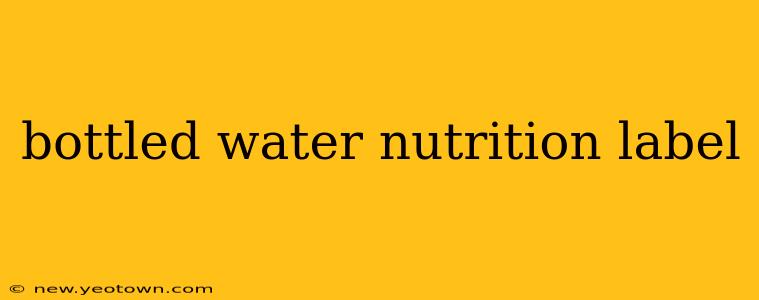Let's be honest, staring at a bottled water nutrition label feels a bit like staring at a blank canvas. After all, it's water, right? But even the simplest things can hold hidden details, and understanding what (or rather, what isn't) on that label can be surprisingly enlightening. This journey into the world of bottled water nutrition labels will uncover the subtle information and address some common questions.
What is typically on a bottled water nutrition label?
This is where things get interesting. You'll likely find very little information on most bottled water labels. Think of it this way: the label's primary job is to declare the purity of the water, not its nutritional content. Most labels will simply state:
- "Water": This is the main ingredient, naturally.
- Source of Water: This indicates where the water comes from (e.g., spring water, purified water, artesian well). This is crucial for understanding the water's journey and potential mineral content.
- Other Minerals (if any): Some bottled waters naturally contain minerals like calcium, magnesium, or potassium. If present, these will be listed. However, many bottled waters are purified, resulting in minimal or no added minerals.
Does bottled water have calories?
No, plain bottled water itself contains zero calories. This is because water doesn't have any caloric content. However, this changes if we're talking about flavored bottled waters, which can contain added sugars and therefore calories. Always check the label for added sugars if you're opting for a flavored variety.
Does bottled water have any nutrients?
The nutritional content of bottled water greatly depends on its source. Spring water may contain trace minerals naturally occurring in the source, while purified water typically undergoes a process that removes most or all minerals. Therefore, while some bottled waters may have trace amounts of minerals, they are generally not a significant source of nutrients.
What is the difference between spring water and purified water?
This is a critical distinction often overlooked. Spring water is collected from an underground source, naturally filtered through the earth, and may contain naturally occurring minerals. Purified water, on the other hand, undergoes a purification process (like reverse osmosis or distillation) that removes impurities and most minerals. This means purified water generally has a cleaner, less mineral-rich taste.
What should I look for on a bottled water label?
While it might seem straightforward, there are a few key things to look for:
- Source: Knowing the source of the water can give you an idea of its mineral content and potential purity.
- "Purified" vs. "Spring": Understand the differences in processing and mineral content.
- Added Ingredients: Be aware of any additives, sweeteners, or flavors. These can impact the calorie and sugar content.
- Packaging: Consider the environmental impact of the plastic bottle. Look for brands committed to sustainable practices.
Is there a nutritional information panel on bottled water?
Most bottled water doesn't require a full nutritional information panel because it contains so few components. A simple statement of the water source and any added minerals usually suffices. However, flavored bottled waters will require a more detailed nutritional panel.
Understanding what's on (and more importantly, what's not on) a bottled water nutrition label allows for informed choices. While the label might be minimalist, the information it provides is crucial to understanding the nature of the product, allowing you to make the choice that best suits your needs and preferences.

